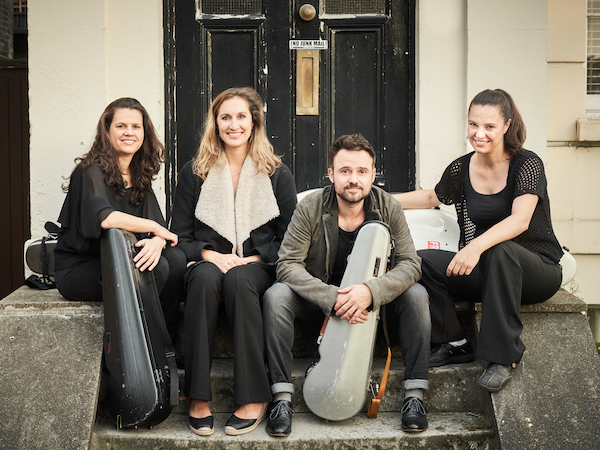Elias Quartet opens Beethoven cycle with breezy spirit and emotional intensity

DACAMERA intended to present a cycle of Beethoven’s string quartets in 2020 to help commemorate the 250th anniversary of the stormy innovator’s birth. As you can probably guess, the pandemic squelched that before it began.
It’s hard to keep Beethoven down, though, and the Houston presenter brought England’s Elias String Quartet to the Menil Collection Monday night to launch the cycle at last.
The quartet (violinists Sara Bitlloch and Donald Grant; violist Simone van der Giessen; and cellist Marie Bitlloch) began its so-called Beethoven Project in 2011, and it has performed the cycle repeatedly in the UK, Europe and United States.
Nevertheless, as violinist Grant pointed out during brief comments after intermission of Monday’s concert, this is the first time the group is performing the quartets in numerical order. For the players, he quipped, it’s convenient at the end of one quartet to simply turn the page and proceed to the next.
Focusing Monday on the first three quartets of Beethoven’s Op. 18 meant, of course, that the group couldn’t spotlight the contrasts or kinships that might appear in a program mixing quartets from different stages in Beethoven’s life. But the concert did offer a vivid picture of the trailblazer in his late 20s—a portrait that was all the more colorful thanks to the Elias quartet’s dramatic range of sound.
The opening of the Quartet No. 1 in F major introduced one of Beethoven’s musical trademarks: a short, speedy motif—in this case, just an F, a quick pirouette, and a C—to propel an entire, vigorous movement. The Adagio cantabile of the Quartet No. 2 in G major revealed Beethoven the trickster, veering from a lyrical opening to a cheerfully chattering fast section that appears out of the blue, then returning to the lyricism.
In the flowing, euphonious start of the Quartet in D major, No. 3, Beethoven tipped his hat to Classical period gentility, whereas the Presto finale unleashed the bounding energy that was pure Beethoven. And while none of the quartets contained fugues, which didn’t become a favorite Beethoven device until later, their occasional bursts of counterpoint—with the players volleying speedy motifs back and forth—hinted at what was to come.
In all three works, the Elias quartet tossed off the breeziest motifs easily, dug into Beethoven’s outbursts, spun out melodies with smoothness and warmth, and played up the contrasts between gusto and grace.
When it came to Beethoven’s emotional intensity, the group generated it most powerfully in the F major quartet’s slow movement. Beethoven told a friend that the Tomb Scene from Shakespeare’s Romeo and Juliet inspired it, and the Elias musicians evidently took that to heart. The lamenting melody that opens the movement began at barely a whisper, and as it unfolded, the gradual crescendo brought out its passion at a visceral level. Even with a spacious tempo, the players kept the sound flowing so insistently that the tension never flagged.
The Elias musicians dug into outbursts with fierce, almost slashing bow strokes, but the tone never lapsed into scratching or scraping. In yet another contrast, they also made Beethoven’s lyricism glow. And at times, they scaled down again to sound so quiet that it seemed to be barely nudged from the strings.
The overall impact of this slow movement looked forward to the mature Beethoven—maybe even Gustav Mahler, when it came to intensity dissolving into dying-away tones. There may have been a downside to go so far into otherworldliness, in that the cheerier scherzo and finale that followed seemed incongruous. But the young Beethoven has hardly sounded more fiery—and his heading for the movement does say appassionato.
In the other quartets, the group lent glow and fervor to the slow movements’ lyricism—as well as a carefree zip to that interruption in the G major quartet’s Adagio. The scherzos boasted coziness and vigor in turn. And in the D major quartet’s surging finale, which closed the evening, the players had a knack for slowing down a bit now and then—giving the return full speed a fresh excitement each time.
Now and then, the players were so intent on giving each motif and episode a profile of its own that momentum sometimes flagged. For instance, when the First Quartet’s opening moved on from that snappy initial motif, the players made it a point to give the more decisive theme that follows a contrasting sturdiness.
That may have weighed things down a bit. But there was no doubt that the Elias Quartet was always engaged in every turn of Beethoven’s music.
The Elias Quartet’s Beethoven cycle runs through April 8 at the Menil Collection and the Hobby Center for the Performing Arts. dacamera.com